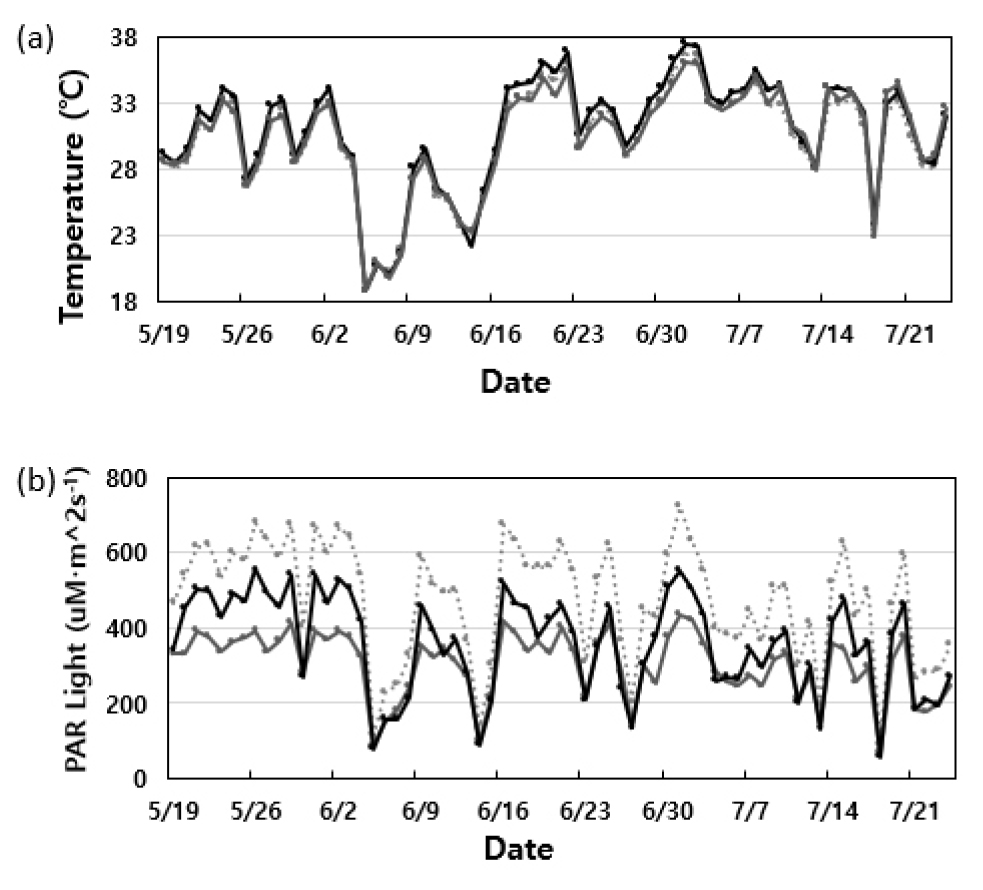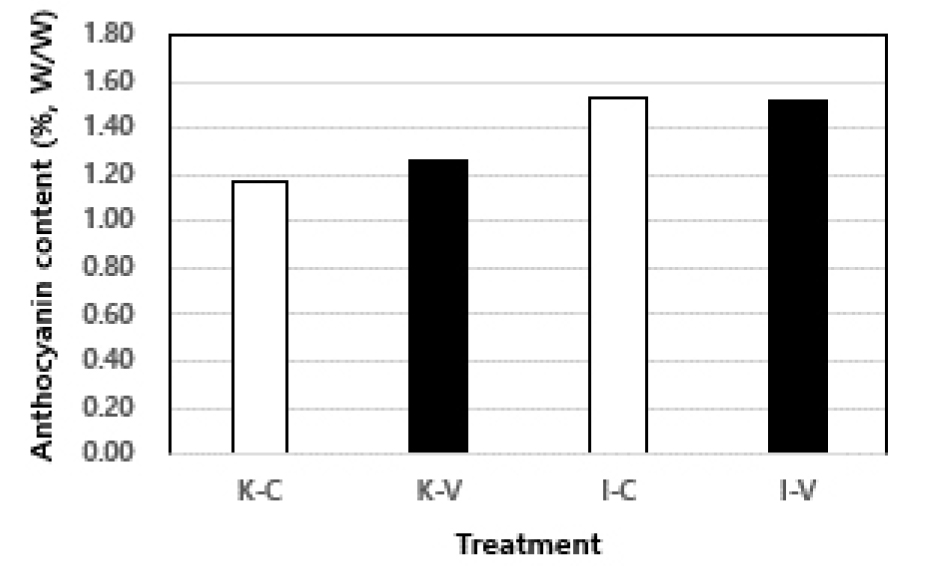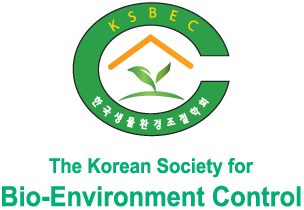서 언
재료 및 방법
1. 포도나무 및 포도원
2. 태양광 패널 설치
3. 포도나무 수체 생육 조사
4. 시설 하부의 미세환경 변화 조사
5. 포도나무 내한성 검정
6. 엽록소 함량 분석
7. 과실 특성조사
8. 토양 분석 및 독성 성분 조사
9. 통계분석
결 과
1. 포도나무의 신초 및 잎의 생육 특성
2. 포도나무 잎의 엽록소 함량 및 색택 특성 비교
3. 포도나무 내한성 검정
4. 포도원 포도 과실 생육 및 특성 비교
5. 포도원 토양 특성 조사 및 독성
고 찰
서 언
영농형 태양광 발전은 영농과 발전을 동시에 진행할 수 있는 시스템으로, 일본에서 solar sharing 개념으로 처음 소개되어 전세계에서 활용되고 있다(Jung 등, 2020; Parkinson과 Hunt, 2020; Sohn 등, 2019). 영농형 태양광 시설은 현재 세계의 여러 나라에서 설치가 증가하고 있으며, 일본, 중국, 프랑스, 미국과 대한민국 등에서는 정부의 지원도 이루어지고 있다(Schindele 등, 2020; Trommsdorff 등, 2021; Vitisphere, 2020; Vollprecht 등, 2021). 서양에서는 차광 실험을 통하여 영농형 태양광 시설에서 재배가 가능한 작물로서 벼, 목화, 콩, 토마토, 상추, 바나나 등을 선발하여 다양한 기준으로 평가를 진행하고 있다(Abdel-Mawgoud 등, 1996; Hernández 등, 2015; Israeli 등, 1995; Marrou 등, 2013a; Ghosh 등, 2018; Zanon 등, 2016).
국내의 포도 산업은 6,930억 규모이며 포도는 레스베라트롤을 비롯한 스틸벤 화합물 등의 기능성 성분 함량이 많이 존재하여 다른 과실에 비해 소비자의 수요가 증가하고 있다(MAFRA, 2021). 또한 국민의 경제수준 향상에 따라 다양한 포도 품종의 요구가 증가하여, ‘캠벨얼리’ 또는 ‘거봉’ 품종에서 ‘샤인머스켓’ 품종의 소비가 늘어나고 있다(KREI, 2021).
유럽과 일본 등의 외국에서는 영농형 태양광시설을 이용한 생산 기술의 개발에 관한 연구가 활발히 진행되고 있으나(Feistel 등, 2018; Jahanfara 등, 2018; Jones 등, 2022), 우리나라에서는 벼와 밭작물, 과수 등의 생산에 태양광 시설을 설치하여 농산물 생산에 미치는 영향 평가 분석과 생산성 향상을 위한 연구가 진행되고 있으나 미미한 실정이다(An 등, 2021; Cho 등, 2021; Jung, 2019; Kang 등, 2021; Kim 등 2019; Kim 등, 2020; Kim, 2020; Kim 등, 2021; Ko 등, 2021; Shin 등, 2021; Yoon 등, 2019).
포도는 다른 과종과 비교하여 과실의 발육과 성숙에 필요한 광포화점이 낮고 특정 품종은 산란광을 요구하기 때문에 영농형 태양광 패널을 설치하고 과실을 생산하는 데에 유리할 것으로 여겨진다. 따라서 본 연구에서는 영농형 태양광 패널을 설치한 포도 과원에서 포도나무 수체의 생육 특성과 과실의 발육 특성을 평가하여 노지에서의 특성과 비교하고자 하였다.
재료 및 방법
1. 포도나무 및 포도원
본 시험에 사용한 포도나무 품종은 ‘캠벨얼리’(Vitis labruscana L.)이며 6-7년생 나무가 웨이크만식 수형으로 재배되고 있는 포도 과원(재식거리 2.6 × 3m, 4,000m2)에 태양광 패널을 설치하였으며 포도원은 경상북도 경산시 영남대학교 부속농장과 인천광역시 옹진군 영흥면에 소재하고 있다. 시험은 2021년과 2022년에 걸쳐 수행하였다.
2. 태양광 패널 설치
포도나무 과수용 영농형 태양광 발전 시스템은 포도나무의 재식열을 고려하여 포도나무의 재식방향과 동일한 방향으로 구조물을 설치하고 해당 구조물에 영농형 태양광 패널(150Wp, 36cell 모듈 48매)을 차광률 30% 미만으로 배치하였다(Fig. 1).
3. 포도나무 수체 생육 조사
포도나무 수체 생육 조사는 맹아기, 엽면적, 엽중, 신초장, 절간장, 절간경을 조사하였다. 신초 생육 특성은 처리당 3주에서 신초 10개를 조사하였으며, 엽면적 측정은 각 처리별로 과실 수확일에 3개의 신초에서 기부엽부터 위로 3매의 잎을 동일하게 채취하여 엽면적 측정기(LI-3000, LI-COR, Inc, Lincoln, NE, USA)를 이용하여 측정하여 단위엽당 면적으로 환산하였으며, 절간경은 신초의 기부로부터 3번째 절간을 조사하였다.
4. 시설 하부의 미세환경 변화 조사
시설 하부의 광량과 온도, 풍속의 변화를 조사하였다. 자료는 자료수집장치(STL-T/RH/A4/D2, STA, Anyang, Korea)에 환경관측센서를 연결하여 사용하였다. 기온센서(STL-T/ RH, STA, Anyang, Korea)는 백색의 태양열 차광통에 넣어서 직사광선이나 빗물로부터 보호하였으며, 기온의 측정범위는 –40℃에서 +120℃이고 측정오차는 +/‒0.3℃, 풍향/풍속센서(Davis, USA)에서 풍향의 측정범위는 0-360도, 측정오차 5도 이내, 풍속의 측정범위는 0-50m/s, 측정오차 +/‒1m/s 이하 이다. 광원의 광도(PPFD)는 spectroradiometer (PAR-200, J&C Tech Co., Ltd., Hwaseong, Korea)를 이용하여 수관 높이(지면으로부터 평균 75cm 높이)에서 측정하였다.
5. 포도나무 내한성 검정
포도나무의 내한성을 비교하기 위하여 이듬해에 온실에서의 눈의 맹아율을 조사하였으며, 휴면 상태의 결과모지의 기부에서 5-8마디의 가지를 12월 21일과 이듬해 1월 24일에 채취하여 수피의 탄수화물 함량을 측정하였다. 채취된 가지의 탄수화물 함량은 수피를 60℃에서 48시간 동안 건조시켜 분쇄한 후 시료 0.5g을 0.7N HCl 용액 20mL에 넣고 99.9℃로 유지되는 항온수조에서 2시간 30분 동안 분해한 후 분해액 3mL에 dinitrosalicylic (DNS) acid 5mL을 첨가하여 다시 5분간 끓인 후 비색계(Model S-3130, Scinco Co., Ltd, Seoul, Korea)를 이용하여 흡광도(A550nm)를 측정하였다(Winkler와 Howel, 1986).
6. 엽록소 함량 분석
포도나무 잎을 80% 아세톤 용액에 침지하여 엽록소를 추출한 후, spectrophotometer (UV/Visible Diode Array, Walden Precision Apparatus Ltd., UK)를 사용하여 파장 663nm와 645nm에서 측정하여 다음의 식으로 환산하였다(Arnon, 1949).
Chlorophyll a = 12.7 A663 − 2.69 A645
Chlorophyll b = 22.9 A645 − 4.68 A663
Total Chlorophyll (a + b) = 20.29 A645 + 8.02 A663
7. 과실 특성조사
시험 처리구당 무작위로 선발한 과방 5개를 대상으로 하여 농사시험연구기준(RDA, 1995)에 따라 과방중, 과립중, 안토시아닌 함량, 당도 및 적정산도를 분석하였다. 가용성 고형물 함량은 굴절당도계(Digital Refractometer PAL-1, Atago, Japan)로 측정하였으며, 산도는 과일 산도측정기(GMK-835N, G-WON HITECH, Korea)를 이용하여 측정하였고, 각각 10개의 과립을 무작위로 선발하고 3반복으로 실시하였다. 안토시아닌 함량은 흡광도계(Multimode Microplate Reader, SPARK, TECAN)를 이용하여 측정하였다(Kwon 등, 2019).
8. 토양 분석 및 독성 성분 조사
토양 시료는 풍건하여 분쇄한 후 표준체(10mesh)로 통과시켜 일반분석용으로 사용하였고, 토양을 다시 유발에 갈아 체(100mesh) 걸음 한 시료를 중금속 분석용으로 사용하였다. 토양의 이화학적 분석은 농촌진흥청 농업과학원 토양화학분석법(NIAST, 1988)에 따라 토양산도는 pH meter, 전기전도도는 EC측정기, 유기물은 Tyurin법, 유효인산은 Lancaster법, 토성분석은 hydrometer를 이용하였다. 토양의 가용성 중금속 분석은 환경부 토양오염공정시험방법(KSTM ES 07552)에 따라 원소를 측정하였다(Kim 등, 2021).
9. 통계분석
통계 처리는 SPSS statistic 18(IBM, US)을 이용하여 T-test를 수행하여 유의성을 분석하였다.
결 과
1. 포도나무의 신초 및 잎의 생육 특성
설치한 태양광 패널이 포도나무 수체의 생육에 영향을 끼치는 지를 분석하고자 2개의 포장에서 태양광 패널을 설치한 처리구와 설치하지 않은 무처리구에서 포도나무 신초의 생육을 조사하였다. 태양광을 설치한 처리구에서 주당 신초수는 17-18, 또는 23-29개로 무처리구의 주당 신초수(25-26개)와 차이가 없었다(Table 1). 처리구의 초장길이는 154cm로 무처리구(146cm)와 차이가 없었으며, 처리구의 신초 당 엽수는 13-14매로 무처리구(13매)와 차이가 없었다. 처리구 식물체 신초의 평균 절간은 12cm이었고, 무처리구 신초의 평균 절간은 11.0cm이고, 신초의 절간 직경은 8mm로서 무처리구의 절간 직경인 8.3mm와 유사하여 신초의 절간과 절간 직경에는 처리구와 무처리구간의 차이가 없었다.
Table 1.
The growth of shoots in vines under agrivoltaic panels in the vineyards.
| Treatment | Budding date |
No. of shoots per vine |
Shoot length (cm) |
No. of leaves per shoot |
Internode diameter (mm) |
Internode length (mm) | |
| Gyeongsan | Control | 4.17 | 18.1 | 91 | 11 | 5.1 | 8.0 |
| Agrivoltaic | 4.19 | 16.9 | 99 | 12 | 5.3 | 9.0 | |
| Significance | NSz | NS | NS | NS | NS | NS | |
| Incheon | Control | 4.17 | 26.7 | 146 | 13 | 8.3 | 11.0 |
| Agrivoltaic | 4.19 | 25.3 | 154 | 13 | 8.0 | 12.0 | |
| Significance | NS | NS | NS | NS | NS | NS | |
포도나무 신초당 3개의 잎(기부로부터 7, 8, 9번째)을 채취하여 엽중과 엽면적, 갈색무늬병의 발생을 조사하였다(Table 2). 두 개 포장에서 태양광 처리구에서 신초 잎의 엽중은 5.2-7.0g으로서 무처리구의 엽중(5.6-8.7g)과 유의차가 없었으며 태양광 처리구의 신초 잎의 엽면적이 226-265mm2로서 무처리구의 엽면적(222-273mm2)에 비해 유의차가 없었다. 태양광 패널 설치에 따른 병해 발생을 비교하고자 갈색무늬병 병반면적률을 조사하였다. 태양광 설치 처리구의 포도나무의 잎에 발생하는 갈색무늬병 발병면적률은 0.2-1.1%로서 무처리구의 잎에 발생한 병반면적률(0.1-4.8%)보다 현저히 낮아 태양광 처리구에서 발생이 적은 경향이었다.
Table 2.
The growth and leaf spot development of vine leaves grown under agrivoltaic panels in the vineyards.
| Region | Treatment | Leaf weight (g) | Leaf area (mm2) | Lesion area of leaf spot in leaves (%) |
| Gyeongsan | Control | 5.6 | 222.0 | 0.1 |
| Agrivoltaic | 5.2 | 226.9 | 0.2 | |
| Significance | NSz | NS | NS | |
| Incheon | Control | 8.7 | 273.5 | 4.8 |
| Agrivoltaic | 7.0 | 265.6 | 1.1 | |
| Significance | NS | NS | * |
2. 포도나무 잎의 엽록소 함량 및 색택 특성 비교
포도나무 잎의 엽록소 함량은 처리구와 무처리구 간에 유의차가 없었지만 태양광 설치 처리구에서 23-50µg·g로서 무처리구의 19-41µg·g보다 높게 나타났다(Table 3). 이는 태양광 패널 설치로 인해 수체의 생육이 늦게까지 유지되었기 때문일 것으로 여겨진다(Table 3). 태양광 설치구에서 신초 잎의 색택을 비교한 결과, 처리구에서는 색도(Hunter value)는 각각 L = 37-41, b* = 11.65-17.59이었으며, 무처리구의 포도나무 잎의 색도는 L = 38-40, b = 14-15로서 처리 간의 유의차가 인정되지 않았다.
Table 3.
Contents of chlorophyll in the leaves of vines under agrivoltaic panels in the vineyards.
| Region | Treatment | Content of chlorophyll (µg/g) | Hunter’s value | ||||||
| chl a | chl b | a/b ratio | total | L | a | b | |||
| Gyeongsan | Control | 14.06 | 4.97 | 2.83 | 19.02 | 40.27 | ‒8.55 | 15.79 | |
| Agrivoltaic | 17.47 | 5.89 | 2.96 | 23.36 | 41.89 | ‒7.54 | 17.59 | ||
| Significance | NSz | NS | - | NS | NS | NS | NS | ||
| Incheon | Control | 27.52 | 13.71 | 2.01 | 41.21 | 38.07 | ‒2.51 | 14.08 | |
| Agrivoltaic | 31.41 | 18.99 | 1.65 | 50.39 | 37.18 | ‒0.94 | 11.65 | ||
| Significance | NS | NS | - | NS | NS | NS | NS | ||
3. 포도나무 내한성 검정
포도나무 수체의 내한성 차이를 비교하기 위하여 가지를 월동 전과 월동 후로 구분하여 채취하고 수피의 탄수화물 함량을 분석하고 월동 삽수의 발아율을 조사하였다. 처리구 가지의 탄수화물 함량은 183-184mg·g-1으로 무처리구의 181-198mg·g-1과 유사하였으나, 채취한 삽수의 발아율은 처리구에서 높게 나타났다(Table 4). 또한 처리구에서는 태양광 설치에 따른 과원의 풍속은 감소하였으나(Fig. 2), 이상기후에 의한 겨울철 극저온이 도래할 경우에는 처리구에서 풍속이 감소함에 따라 월동하는 포도나무에서 건조에 의한 동해 발생 및 피해는 감소할 것으로 여겨진다.
Table 4.
Carbohydrate content of stem bark from grapevines over-wintered under an agrivoltaics and open field of vineyards located in Incheon.
| Cutting harvesting date | Treatment | Carbohydrate content (mg·g-1) | Bud burst (%) |
| Dec. 21, 2021 | Control | 181.3 | 54.2 |
| Agrivoltaic | 184.3 | 50.0 | |
| Significance | NSz | NS | |
| Jan. 24, 2022 | Control | 198.9 | 66.5 |
| Agrivoltaic | 183.4 | 75.0 | |
| Significance | NS | * |
4. 포도원 포도 과실 생육 및 특성 비교
태양광 패널 처리구에서의 포도 과실의 생육 특성과 품질의 변화를 비교하였으며, 모든 조사는 3반복으로 수행하였다. 처리구의 포도 과실의 과방중은 253-327g이었고, 무처리구의 과방중은 257-340g이었다(Table 5). 과방장과 과방경은 162-165.6mm과 80.5-94.4mm로서 무처리구의 과방장(144.2-183.2mm) 및 과방경(76.7-93.4mm)과 차이가 없었다. 과립중은 5.6-5.7g으로 무처리의 과립중(5.9-6.1g)과 유의차가 없었다(Table 5).
Table 5.
Growth of grapes harvested from vines under an agrivoltaics and in open field of vineyards.
| Region | Treatment | Cluster weight (g) | Length of cluster (mm) | Cluster diameter (mm) | Berry weight (g) |
| Gyeongsan | Control | 257.2 | 160.0 | 86 | 6.1 |
| Agrivoltaic | 253.2 | 163.3 | 89 | 5.6 | |
| Significance | NSz | NS | NS | NS | |
| Incheon | Control | 340.1 | 163.4 | 88 | 5.9 |
| Agrivoltaic | 327.9 | 164.4 | 95 | 5.7 | |
| Significance | NS | NS | NS | NS |
태양광 패널을 설치한 처리구에서 성숙한 후 수확한 포도 과실의 당함량은 14.0-15.5%이었고, 무처리구의 당함량은 14.9-15.2%와 유의차는 없었다(Table 6). 과실의 적정산도 역시 처리구 간 유의차는 없었으나 처리구에서 포도 과실에서는 0.56-0.76%로, 무처리구 산함량(0.51-0.63%)에 비해 높게 유지되었다(Table 6). 이는 태양광 시설에 의해 처리구의 광량이 감소하여(Fig. 3) 과실에서 성숙이 지연되기 때문으로 여겨진다.
Table 6.
Characteristics of grapes harvested from vines under an agrivoltaics and in open field of vineyards.
| Region | Treatment | Hunter value | Total soluble solid (ºBx) | Titrable acidity (%) | Harveting date | ||
| L | a | b | |||||
| Gyeongsan | Control | 25.1 | ‒3.0 | ‒0.1 | 14.9 | 0.55 | 8.7 |
| Agrivoltaic | 26.6 | ‒2.0 | 0.0 | 15.5 | 0.54 | 8.12 | |
| Significance | NSz | NS | NS | NS | NS | * | |
| Incheon | Control | 28.2 | ‒3.7 | 0.2 | 15.2 | 0.60 | 8.31 |
| Agrivoltaic | 28.0 | ‒3.1 | ‒0.3 | 14.6 | 0.56 | 9.10 | |
| Significance | NS | NS | NS | NS | NS | * | |
수확한 포도 과실의 과피의 안토시아닌 함량은 처리구와 무처리구에서 모두 0.7-0.9%로서 차이가 없었다(Fig. 4). 처리구에서의 적정 수확기는 경산지역에서는 8월 12일, 인천 지역에서는 9월 4-10일경으로 무처리구의 8월 12일, 8월 26-31일에 비해 7-10일 정도 지연되었다(Table 6).
5. 포도원 토양 특성 조사 및 독성
태양광 패널 설치에 따른 토양의 이화학적 성질변화와 구조물의 설치에 따른 독성물질의 발생 여부를 조사하기 위하여 처리구와 무처리구로 구분하여 무작위로 상층토와 하층토를 구분하여 총 8개의 토양 시료를 채취하였다. 식물의 생육과 관련한 토양성분은 산도와 유기물 함량, 유효인산, 칼슘 함량, 마그네슘 함량과 전기전도도는 시설과 무처리간의 유의적인 상관관계가 나타나지 않았다(Table 7). 칼륨 함량에는 처리와 시설구간에 차이가 있으나 향후 더욱 많은 시료를 대상으로 한 분석이 요구된다. 또한 중금속인 수은, 납, 비소, 카드뮴 등의 성분은 토양오염우려기준보다 낮은 함량으로 검출되었으며 시설과 무처리간의 차이도 나타나지 않았다(Table 8).
Table 7.
Chemical properties of soil in vineyards in Incheon.
Table 8.
Content of toxic chemicals in the soil of vineyards.
| Treatment | Hg (mg·kg-1) | Pb (mg·kg-1) | As (mg·kg-1) | Cd (mg·kg-1) | |
| Top soil | Cz | 0.032-0.0041 | 14.37-15.84 | 1.62-1.85 | NDy |
| V | 0.028-0.038 | 12.49-16.76 | 1.25-3.09 | ND | |
| Deep soil | C | 0.034-0.044 | 14.79-15.94 | 1.69-2.20 | ND |
| V | 0.037-0.039 | 13.30-14.79 | 2.03-2.60 | ND | |
| Risk level in Soil Quality Standard | 4 | 200 | 25 | 4 | |
고 찰
영농형 태양광은 경지에서 식물과 에너지를 동시에 생산할 수 있는 시스템으로(Parkinson과 Hunt, 2020), 식물이 이용할 수 있는 광포화점 이상의 빛을 이용하여 전기를 생산하는 것이 영농형 태양광이다. 그러나, 영농형 태양광 시설 하에서의 차광으로 광량이 감소하기 때문에(Cossu 등, 2020) 식물의 생육에 필수적인 광량의 감소는 작물의 생산량 감소와 품질 저하를 초래할 수 있다(Cossu 등, 2020; Loik 등, 2017). 따라서 빛에 대한 반응은 작물에 따라 차이가 크기 때문에 영농형 태양광 시설 하에서 재배가 가능한 적정 작물의 선정과 재배 기술의 개발에 관한 연구가 진행되고 있다(Aroca-Delgado 등, 2018; Cossu 등, 2017; Gonocruz 등, 2021; Marrou 등, 2013b; Murchie, 2002; Touil 등, 2021).
포도 과실의 생산에 있어서 광보상점과 광포화점은 매우 중요하며, 광포화점은 작물의 종류에 따라 다른 특징을 보이며, 포도나무의 광포화점은 40-6klux로서 과실의 생육 및 성숙에 빛이 요구된다(Lim, 2015). 부족한 빛은 포도나무의 생육과 과실의 발육을 방해하기 때문에(Keller 등, 1998; Koyama 등, 2012) 포도나무의 수형 개선을 통한 광투과율 향상이 중요하다(Reynold와 Vanden Heuvel, 2009). 그러나, 광포화점 이상의 빛을 받을 경우, 식물체에서는 자체의 생장을 억제하는 광저해 현상이 나타나, 식물의 생장과 생산성의 저하를 초래한다(Cheng 등, 2016; Takahashi와 Badger, 2011).
차광에 의해서 포도의 과실 발육은 지연되지만 당함량에는 영향이 없었고, 과립의 비대는 증가하였다고 보고되었다(Abeysinghe 등, 2019; Caravia 등, 2016; Greer와 Weedon 2012). 그러나, 포도 생육기인 여름철 높은 photon flux densities (PFDs)과 그로 인한 고온은 포도의 정상적인 생육을 저해한다(Webb 등, 2009). 프랑스에서는 와인 생산용 포도 재배에 태양광 시설을 설치하여, 최근에 기록적인 고온과 높은 일사량으로 인해 발생하는 포도 과수의 스트레스를 최소화하여 과립 비대 촉진, 당도 향상, 안토시아닌과 산 함량의 증가를 꾀하고 있으나(Reasoners와 Ghosh, 2022; Vitisphere, 2020), 향후 포도나무 수체 생육, 광합성 효율, 페놀화합물 축적 등에 대한 효과도 검토되어야 할 것이다(Abeysinghe 등, 2019; Iland 등, 2011). 인도에서는 포도 과원에 태양광을 설치함으로써 포도 생산을 통해 얻는 수익보다 15배 이상의 경제적 효과를 가져온다고 보고하고 있다(Malu 등, 2017).
태양광 시설 처리구에서 포도나무 갈반병의 발생이 적게 관찰되었다. 영농형 태양광 시설하부에서는 생육기 동안에 지상부의 온도 저하, 토양의 온도 상승의 억제 및 수분유지에 도움을 주어 수체의 생육을 촉진하는 것으로 보고되어 있다(Adeh 등, 2018; Marrou 등, 2013a). 따라서 시설 설치에 따라 식물체의 생육에 적합한 기상 조건이 제공되어 식물체의 생육이 왕성하게 유지된 것으로 여겨지며, 이로 인해 병해의 발생도 감소한 것으로 여겨진다. 또한 농업환경 측면에서 영농형태별로 토양의 특성이 변화하거나, 농업자재에 의한 농경지의 중금속 오염이 발생할 수 있고(Jung 등, 2004), 중금속의 오염은 비오염지에 비해 토양산도 양이온치환용량 등 토양화학성의 영향을 받는다(McGrath, 1996). 그러나 본 연구에서는 처리구 토양에서는 이화학적 성질 변화가 나타나지 않았고, 이로 인한 독성 성분이나, 구조물 설치로 인해 발생할 수 있는 토양의 독성 성분도 발생하지 않아 태양광 시설의 토양 환경에는 영향을 미치지 않는 것으로 여겨진다.
본 실험에서는 태양광 패널을 설치한 처리구에서 포도나무 수체의 생육과 발육은 무처리구에 비해 큰 차이가 나타나지 않았으나 숙기가 7일 정도 지연되었다. 이는 영농형 태양광을 도입하려면 성숙을 지연하는 질소질 비료의 시비를 줄이고 칼륨, 인산 등의 시비량을 늘리는 재배법의 개발이 필요하다는 것을 의미한다. 그러나 완숙이 된 포도 과실의 특성과 발육은 무처리구에 비해 큰 차이가 없었으며, 잎의 생육이 약간 촉진되고 병해 발생이 억제되었는데 이는 태양광 패널 시설의 설치에 따라 광과 복사열로 인한 식물체의 스트레스가 감소하였기 때문으로 여겨진다. 태양광 패널을 설치함에 따라 햇빛의 복사열로 인한 여름철 기온 및 지온 상승의 방지와 토양의 수분 증발 억제를 통해 열과 방지 등의 포도 생육에 유리한 효과를 기대할 수 있다. 영농형 태양광은 지속적인 수요 증가와 농가의 새로운 소득사업으로 중요한 의미를 지닌다. 따라서 향후 태양광 패널 시설 하부 경지에서 농작물 수량 및 품질 감소를 최소화하면서 포도를 비롯한 농작물을 안정적으로 생산할 수 있는 재배기술의 개발이 요구된다.








